The good boy who turns to crime because he lives in a bad neighborhood is a common fixture of popular culture. Now that narrative has a newly discovered analogy in the world of cell biology. Professor of stem cell and regenerative biology and Jordan professor of medicine David Scadden and colleagues have demonstrated for the first time that changes in an environmental niche can actually cause disease. “Good” cells can turn “bad” in a bad neighborhood—leading to cancer.
In cancer, a “single cell goes awry,” explains Scadden. This is thought to happen when the cell accumulates a series of genetic injuries that break down the internal mechanisms controlling such events as how many times it can divide and how long it lives. The cancer then creates daughter cells that can travel and establish new colonies—but not just anywhere. Different kinds of cancers have affinities for colonizing particular organs: prostate cancer goes to bone, breast cancer to brain and lung, pancreatic cancer to liver, for example. This has led scientists to try to define the facilitating properties of those particular surrounding environments.
Scadden has studied the importance of environmental niches in determining cell fate for years. He has shown, for example, that characteristics of a bone microenvironment can determine what type of cell a blood stem cell (in bone marrow) will become. But the idea that the environment could actually be involved in the initiation of a new cancer was not well defined until his recent discovery, which was published in Nature earlier this year.
Scadden, who co-chairs the University’s department of stem cell and regenerative biology, found that when he and his team made a genetic alteration in bone cells that surrounded healthy blood stem cells in mice, the mice developed myelodysplasia, a disease that, in humans, frequently leads to an aggressive, generally fatal form of leukemia. The result was unexpected but consistent with cases of myelodysplasia in humans: many patients develop the disease despite having normal blood cells prior to its onset. Such patients may have had undiagnosed genetic abnormalities in their bones.
Exactly how the environment interacts with stem cells to make them “go bad” is something Scadden’s group is now trying to work out. One possibility is that the environment provides a kind of “fitness check.” Cells that accumulate abnormalities might in a healthy environment receive signals instructing them to die, Scadden explains—messages the damaged cells never receive in a compromised environment.
Whatever the mechanism, the implications for therapy are enormous. Fixing problems within cells—rewiring a cell that has become cancerous, for example—is difficult. The new finding suggests that “the interface between one cell type and another can be a component of the development and maintenance of cancer,” Scadden points out. “Exchanges between cell types have to be happening at the cell surface”—and could therefore become a target for drug or antibody therapy. “We have been focusing on cancer cells as autonomous units,” he continues. “But this says that cancer cells are actually part of a tissue and—like normal cells—they respond to signals.
“We’ve expanded the orbit for potential therapies,” he explains. “The trend toward stem-cell science ramifications in areas where we didn’t anticipate any direct connection is continuing to expand. This is a perfect example.”









